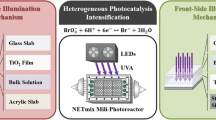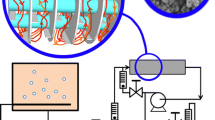Abstract
A compact reactor for photocatalytic oxidation and photocatalytic ozonation water treatment was developed and evaluated by using four model pollutants. Additionally, combinations of pollutants were evaluated. Specially produced Al2O3 porous reticulated monolith foams served as TiO2 carriers, offering a high surface area support. UV lamps were placed in the interior to achieve reduced dimensions of the reactor (12 cm in diameter × 20 cm in height). Despite its small size, the overall photocatalytic cleaning capacity was substantial. It was evaluated by measuring the degradation of LAS + PBIS and RB19 as representatives of surfactants and textile dyes, respectively. These contaminants are commonly found in household grey wastewater with phenol as a trace contaminant. Three different commercial photocatalysts and one mixture of photocatalysts (P25, P90, PC500 and P25 + PC500) were introduced in the sol-gel processing and immobilized on foamed Al2O3 monoliths. RB19 and phenol were easily degradable, while LAS and PBIS were more resistant. The experiments were conducted at neutral-acidic pH because alkaline pH negatively influences both photocatalyic ozonation (PCOZ) and photocatalysis. The synergistic effect of PCOZ was generally much more expressed in mineralization reactions. Total organic carbon TOC half lives were in the range of between 13 and 43 min in the case of individual pollutants in double-deionized water. However, for the mixed pollutants in tap water, the TOC half-life only increased to 53 min with the most efficient catalyst (P90). In comparison to photocatalysis, the PCOZ process is more suitable for treating wastewater with a high loading of organic pollutants due to its higher cleaning capacity. Therefore, PCOZ may prove more effective in industrial applications.










Similar content being viewed by others
References
Agustina TE, Ang HM, Vareek VK (2005) A review of synergistic effect of photocatalysis and ozonation on waste water treatment. J Photochem Photobiol C: Photochem Rev 6:264–273
Beltran FJ, Aguinaco A, Garcia-Araya JF (2010) Kinetic modelling of TOC removal in the photocatalytic ozonation of diclofenac aqueous solutions. Appl Catal B Environ 100:289–298
Beltran FJ, Garca-Araya JF, Alvarez PM (2000) Sodium dodecylbenzenesulfonate removal from water and waste water. 1. Kinetics of decomposition by ozonation. Ind Eng Chem Res 39:2214–2220
Beltran FJ, Rivas FJ, Gimeno O (2005) Comparison between photocatalytic ozonation and other oxidation processes for the removal of phenols from water. J Chem Technol Biotechnol 80:973–984
Bradley B, Daigger G, Rubin R, Tchobanoglous G (2002) Evaluation of onsite waste water treatment technologies using sustainable development criteria. Clean Techn Environ Policy 4:87–99
Busca G, Berardinelli S, Resini C, Arrighi L (2008) Technologies for the removal of phenol from fluid streams: a short review of recent developments. J Hazard Mater 160:265–288
Camacho-Munoz D, Martin J, Santos JL et al (2014) Occurrence of surfactants in waste water: hourly and seasonal variations in urban and industrial waste waters from Seville (southern Spain). Sci Total Environ 468–469:977–984
Cernigoj U, Stangar UL, Jirkovsky J (2010) Effect of dissolved ozone or ferric ions on photodegradation of thiacloprid in presence of different TiO2 catalysts. J Hazard Mater 177:399–406
Cernigoj U, Stangar UL, Trebse P (2007) Degradation of neonicotinoid insecticides by different advanced oxidation processes and studying the effect of ozone on TiO2 photocatalysis. Appl Catal B Environ 75:229–238
Chen TY, Kao CM, Hong A et al (2009) Application of ozone on the decolorization of reactive dyes—Orange-13 and Blue-19. Desalination 249:1238–1242
Chen Y, Xie Y, Yang J et al (2014) Reaction mechanism and metal ion transformation in photocatalytic ozonation of phenol and oxalic acid with Ag+/TiO2. J Environ Sci 26:662–672
Cherifi H, Hanini S, Bentahar F (2009) Adsorption of phenol from wastewater using vegetal cords as a new adsorbent. Desalination 244:177–187
Chong MN, Jin B, Chow CWK, Saint C (2010) Recent developments in photocatalytic water treatment technology: a review. Water Res 44:2997–3027
Coleman HM, Marquis CP, Scott JA et al (2005) Bactericidal effects of titanium dioxide-based photocatalysts. Chem Eng J 113:55–63
Dominguez JR, Beltran J, Rodriguez O (2005) Vis and UV photocatalytic detoxification methods using TiO2, TiO2/H2O2, TiO2/O3, TiO2/S2O8 2−, O3, H2O2, S2O8 2−, Fe3+/H2O2 and Fe3+/H2O2/C2O4 2− for dyes treatment. Catal Today 101:389–395
Esplugas S, Gimenez J, Contreras S et al (2002) Comparison of different advanced oxidation processes for phenol degradation. Water Res 36:1034–1042
Etchepare R, Hoek JP (2015) Health risk assessment of organic micropollutants in greywater for potable reuse. Water Res 72:86–98
Fountoulakis MS, Terzakis S, Kalogerakis N, Manios T (2009) Removal of polycyclic aromatic hydrocarbons and linear alkylbenzene sulfonates from domestic waste water in pilot constructed wetlands and a gravel filter. Ecol Eng 35:1702–1709
Gaya UI, Abdullah AH (2008) Heterogeneous photocatalytic degradation of organic contaminants over titanium dioxide: a review of fundamentals, progress and problems. J Photochem Photobiol C: Photochem Rev 9:1–12
Gimeno O, Rivas FJ, Beltran FJ, Carbajo M (2007) Photocatalytic ozonation of winery waste waters. J Agric Food Chem 55:9944–9950
Guimaraes JR, Maniero MG, de Araujo RN (2012) A comparative study on the degradation of RB-19 dye in an aqueous medium by advanced oxidation processes. J Environ Manag 110:33–39
Gupta VK, Ali I, Saleh TA, Nayak A, Agarwal S (2012) Chemical treatment technologies for waste-water recycling—an overview. RSC Adv 2:6380–6388
He Z, Lin L, Song S et al (2008) Mineralization of C.I. Reactive Blue 19 by ozonation combined with sonolysis: performance optimization and degradation mechanism. Sep Purif Technol 62:376–381
Hernandez-Leal L, Temmink H, Zeeman G, Buisman CJN (2011) Removal of micropollutants from aerobically treated grey water via ozone and activated carbon. Water Res 45:2887–2896
Horn TB, Zerwes FV, Kist LT, Machado EL (2014) Constructed wetland and photocatalytic ozonation for university sewage treatment. Ecol Eng 63:134–141
Ji Y, Zhou L, Ferronato C, Salvador A, Yang X, Chovelon JM (2013) Degradation of sunscreen agent 2-phenylbenzimidazole-5-sulfonic acid by TiO2 photocatalysis: kinetics, photoproducts and comparison to structurally related compounds. Appl Catal B Environ 140–141:457–467
Jing Y, Li L, Zhang Q et al (2011) Photocatalytic ozonation of dimethyl phthalate with TiO2 prepared by a hydrothermal method. J Hazard Mater 189:40–47
Kete M, Pavlica E, Fresno F et al (2014) Highly active photocatalytic coatings prepared by a low-temperature method. Environ Sci Pollut Res 21:11238–11249
Liu Y, Hua L, Li S (2010) Photocatalytic degradation of reactive brilliant blue KN-R by TiO2/UV process. Desalination 258:48–53
Lu J, Zhang T, Ma J, Chen Z (2009) Evaluation of disinfection byproducts formation during chlorination and chloramination of dissolved natural organic matter fractions isolated from a filtered river water. J Hazard Mater 162:140–145
Lucas MS, Peres JA, Lan BY, Puma GL (2009) Ozonation kinetics of winery waste water in a pilot-scale bubble column reactor. Water Res 43:1523–1532
Mahne D, Stangar UL, Trebse P, Bulc TG (2012) TiO2-based photocatalytic treatment of raw and constructed-wetland pretreated textile wastewater. Int J Photoenergy 2012:1–12. doi:10.1155/2012/725692
Malato S, Fernandez-Ibanez P, Maldonado MI et al (2009) Decontamination and disinfection of water by solar photocatalysis: recent overview and trends. Catal Today 147:1–59
Marques SM, Tavares CJ, Oliveira LF, Oliveira-Campos AMF (2010) Photocatalytic degradation of C.I. Reactive Blue 19 with nitrogen-doped TiO2 catalysts thin films under UV/visible light. J Mol Struct 983:147–152
Nasuhoglu D, Rodayan A, Berk D, Yargeau V (2012) Removal of the antibiotic levofloxacin (LEVO) in water by ozonation and TiO2 photocatalysis. Chem Eng J 189-190:41–48
Ochuma IJ, Osibo OO, Fishwick RP et al (2007) Three-phase photocatalysis using suspended titania and titania supported on a reticulated foam monolith for water purification. Catal Today 128:100–107
Oller I, Malato S, Sánchez-Pérez JA (2011) Combination of advanced oxidation processes and biological treatments for wastewater decontamination—a review. Sci Total Environ 409:4141–4166
Oyama T, Otsu T, Hidano Y et al (2011) Enhanced remediation of simulated waste waters contaminated with 2-chlorophenol and other aquatic pollutants by TiO2-photoassisted ozonation in a sunlight-driven pilot-plant scale photoreactor. Sol Energy 85:938–944
Panda KK, Mathews AP (2014) Ozone oxidation kinetics of Reactive Blue 19 anthraquinone dye in a tubular in situ ozone generator and reactor: modeling and sensitivity analyses. Chem Eng J 255:553–567
Pera-Titus M, Garcia-Molina V, Banos MA et al (2004) Degradation of chlorophenols by means of advanced oxidation processes: a general review. Appl Catal B Environ 47:219–256
Petrenko VI, Avdeev MV, Garamus VM et al (2010) Micelle formation in aqueous solutions of dodecylbenzene sulfonic acid studied by small-angle neutron scattering. Colloids Surf A Physicochem Eng Asp 369:160–164
Petrie B, Barden R, Kasprzyk-Hordern B (2015) A review on emerging contaminants in wastewaters and the environment: current knowledge, understudied areas and recommendations for future monitoring. Water Res 72:3–27
Plesch G, Vargova M, Vogt UF et al (2012) Zr doped anatase supported reticulated ceramic foams for photocatalytic water purification. Mater Res Bull 47:1680–1686
Quist-Jensen CA, Macedonio F, Drioli E (2015) Membrane technology for water production in agriculture: desalination and wastewater reuse. Desalination 364:17–32
Raupp GB, Alexiadis A, Hossain MM, Changrani R (2001) First-principles modeling, scaling laws and design of structured photocatalytic oxidation reactors for air purification. Catal Today 69:41–49
Richardson JT, Peng Y, Remue D (2000) Properties of ceramic foam catalyst supports: pressure drop. Appl Catal A Gen 204:19–32
Richardson SD (2008) Environmental mass spectrometry: Emerging contaminants and current issues. Analytical Chemistry 80:4373–4402
Rivas FJ, Beltran FJ, Encinas A (2012) Removal of emergent contaminants: integration of ozone and photocatalysis. J Environ Manag 100:10–15
Rodriguez EM, Fernandez G, Alvarez PM, Beltran FJ (2012) TiO2 and Fe(III) photocatalytic ozonation processes of a mixture of emergent contaminants of water. Water Res 46:152–166
Salaeh S, Kovacic M, Kosir D, Kusic H, Stangar UL, Dionysiou DD, Bozic AL (2017) Reuse of TiO2-based catalyst for solar driven water treatment: thermal and chemical reactivation. J Photochem Photobiol A Chem 333:117–129
Suarez S, Carballa M, Omil F, Lema JM (2008) How are pharmaceutical and personal care products (PPCPs) removed from urban waste waters. Rev Environ Sci Biotechnol 7:125–138
Suligoj A, Cernigoj U, Stangar UL (2010) Preparation procedure of durable titania coatings on metal supports for photocatalytic cleaning applications. Patent number SI 23585 A. The Slovenian Intellectual Property Office, Ljubljana
Twigg MV, Richardson JT (2007) Fundamentals and applications of structured ceramic foam catalysts. Ind Eng Chem Res 46:4166–4177
Vargova M, Plesch G, Vogt UF et al (2011) TiO2 thick films supported on reticulated macroporous Al2O3 foams and their photoactivity in phenol mineralization. Appl Surf Sci 257:4678–4684
Willis RM, Stewart RA, Giurco DP et al (2011) End use water consumption in households: impact of socio-demographic factors and efficient devices. J Clean Prod 60:107–115
Wintgens T, Melin T, Salehi F, Hochstrat R (2008) Emerging contaminants and treatment options in water recycling for indirect potable use. Water Sci Technol 57:99–107
Yang H, Cheng H (2007) Controlling nitrite level in drinking water by chlorination and chloramination. Sep Purif Technol 56:392–396
Yildirim AO, Gul S, Eren O, Kusvuran E (2011) A comparative study of ozonation, homogeneous catalytic ozonation, and photocatalytic ozonation for C.I. Reactive Red 194 azo dye degradation. CLEAN - Soil, Air, Water 39:795–805
Zsilak Z, Szabo-Bardos E, Fonagy O et al (2014) Degradation of benzenesulfonate by heterogeneous photocatalysis combined with ozonation. Catal Today 230:55–60
Acknowledgements
This work has been financially supported by Electrolux S.P.A. and the Slovenian Research Agency (research core funding no. P2-0377 and P1-0134, Belgian-Slovenian project “Development of advanced TiO2-based photocatalyst for the degradation of organic pollutants from wastewater”). The doctoral study of M. Kete was partly cofinanced by the European Union through the European Social Fund. Cofinancing was carried out within the framework of the Operational Program for Human Resources Development for 2007–2013, 1. Development priority: Promoting entrepreneurship and adaptability; priority 1.3: Scholarship Scheme. The doctoral study of O. Pliekhova has been funded by INFINITY project in the framework of the EU Erasmus Mundus Action 2.
Author information
Authors and Affiliations
Corresponding author
Additional information
Responsible editor: Suresh Pillai
Rights and permissions
About this article
Cite this article
Kete, M., Pliekhova, O., Matoh, L. et al. Design and evaluation of a compact photocatalytic reactor for water treatment. Environ Sci Pollut Res 25, 20453–20465 (2018). https://doi.org/10.1007/s11356-017-9895-3
Received:
Accepted:
Published:
Issue Date:
DOI: https://doi.org/10.1007/s11356-017-9895-3




